The trek, as far as this blog is concerned, is coming to a close. The final three posts begin with this one, food. You will then learn about the horses and finally, my favorite, the yaks of the Himalaya.
Let’s begin with local food we would see along the way. At the lower elevations, there was farming in terraced fields. Periodically we would see shallow baskets on stone walls or metal roofs filled with local produce. 

 This looks like little peppers.
This looks like little peppers.
 We thought this might be potato at first but our guide took a little nibble and decided it was radish.
We thought this might be potato at first but our guide took a little nibble and decided it was radish.

At the tea lodges we would go in and sit down. Nutan, our guide, or Dilip, our Sherpa, would grab this notebook from a stack on the front counter and begin taking our orders. They would keep a list of what we ordered, how much electricity we purchased to recharge batteries for phones or cameras, any showers, bottled water and our lodging and on the final morning Nutan would add it up and tell us what we owed. The most expensive stay was in Dingboche where we stayed three nights, had eight meals, several bottles of water, and two hot showers. The cost 9,315 Rupees which was about $93 USD…for BOTH of us!
 Breakfast was pretty normal by our standards. We could have Eggs, toast and sausage.
Breakfast was pretty normal by our standards. We could have Eggs, toast and sausage.
 Muesli and warm milk with fruit and nuts which I had six times.
Muesli and warm milk with fruit and nuts which I had six times.
 French toast showed up on the menu at the last tea lodge.
French toast showed up on the menu at the last tea lodge.
 Tibetan bread which was a sweet version of Navajo Fry Bread.
Tibetan bread which was a sweet version of Navajo Fry Bread.
 Hard boiled eggs and toast was also an option.
Hard boiled eggs and toast was also an option.
For lunch and dinner, I’m just going to combine the options since it was off the same menu. They did not provide separate lunch and dinner options.
 They called these Momos which are what we call Pot Stickers. You could get them fried or not. These are not.
They called these Momos which are what we call Pot Stickers. You could get them fried or not. These are not.
 The most common thing we ordered was fried noodles or fried rice. We started sharing the rice and ordering a Sherpa Stew along with it which made for a yummy meal. Sherpa stew was like a vegetable soup with thick broth.
The most common thing we ordered was fried noodles or fried rice. We started sharing the rice and ordering a Sherpa Stew along with it which made for a yummy meal. Sherpa stew was like a vegetable soup with thick broth. 

This is the ONE meal we DID NOT LIKE…tuna and mushroom pizza. That’s right. I think what made it hard to eat was the ketchup base versus using actual marinara sauce. And very little cheese. Seafood should not be on pizza. Just my opinion.

Higher up on the trail french fried started showing up on menus. They were the BEST fries we have ever eaten. Maybe because we think they were locally grown. They became a staple.
 For dinner, we’d put a little cheese and egg on them and thoroughly enjoy the meal.
For dinner, we’d put a little cheese and egg on them and thoroughly enjoy the meal.
 Another favorite was Dal Bati, an Indian Hindi food serve, in this case, with two hard-boiled eggs in the curry. The platter consists of unleavened bread, lentil soup, rice and the bowl of curry soup.
Another favorite was Dal Bati, an Indian Hindi food serve, in this case, with two hard-boiled eggs in the curry. The platter consists of unleavened bread, lentil soup, rice and the bowl of curry soup.
The food was good but after 20 some odd meals having the same thing each day grew tiresome.

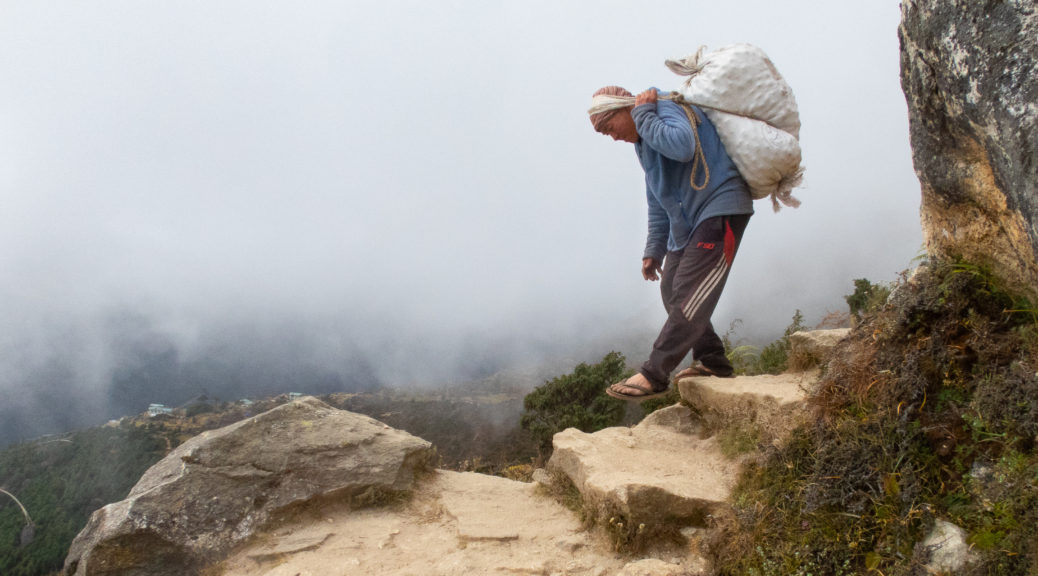
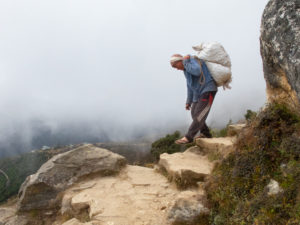 They wore flip-flops…
They wore flip-flops…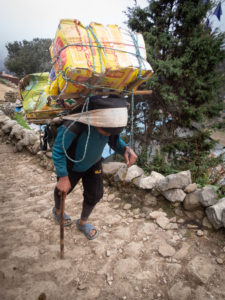 …slide in sandals…
…slide in sandals… 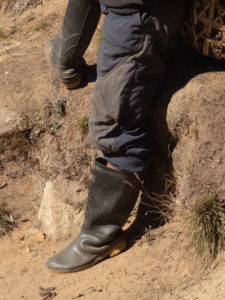 …and rubber boots.
…and rubber boots.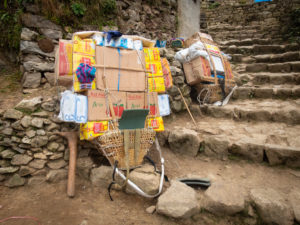 I have no idea what is in these boxes and packages but this looks like it must weigh FAR more than 60 pounds.
I have no idea what is in these boxes and packages but this looks like it must weigh FAR more than 60 pounds.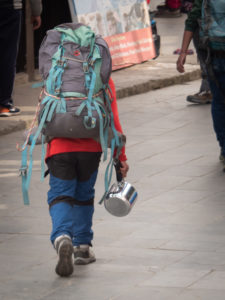 I found this interesting. See the belt strap on this backpack? It’s meant to distribute the weight of the pack to the hips thus alleviating strain on the shoulders, right? It’s not connected. The porters carry their weight with a strap across their heads. It didn’t matter if it was a backpack or traditional basket.
I found this interesting. See the belt strap on this backpack? It’s meant to distribute the weight of the pack to the hips thus alleviating strain on the shoulders, right? It’s not connected. The porters carry their weight with a strap across their heads. It didn’t matter if it was a backpack or traditional basket.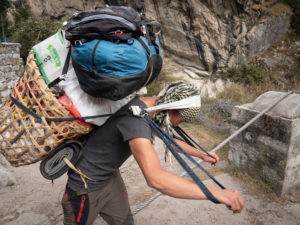 The straps he’s holding are used to balance the load.
The straps he’s holding are used to balance the load.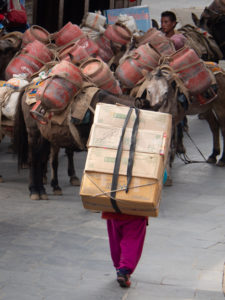 This guy is walking through Lukla and approaching a mule train loaded with propane tanks. I can’t help but wonder how far he’s going. The other amazing thing? We walked with daypacks full of water and extra clothing. The porters seemed to have nothing.
This guy is walking through Lukla and approaching a mule train loaded with propane tanks. I can’t help but wonder how far he’s going. The other amazing thing? We walked with daypacks full of water and extra clothing. The porters seemed to have nothing.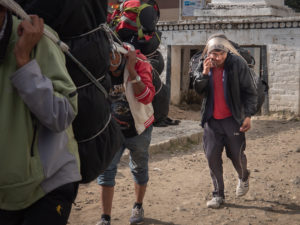
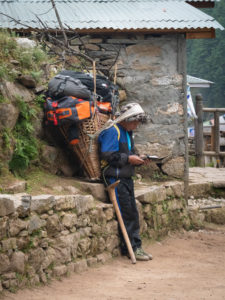 It seems this guy may have been setting up his next job.
It seems this guy may have been setting up his next job.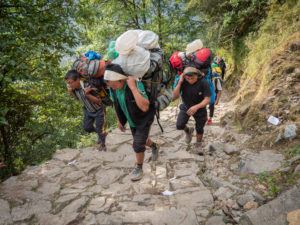 As with the animal pack trains, we always stepped out of the way and let the porters have a clear path with their loads.
As with the animal pack trains, we always stepped out of the way and let the porters have a clear path with their loads.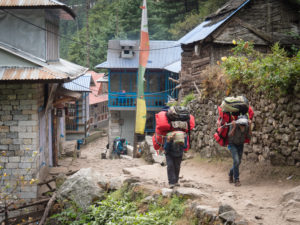 SUCH a common sight.
SUCH a common sight.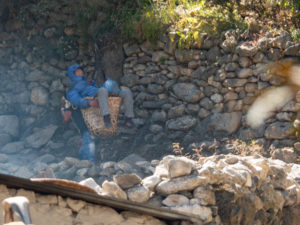 Not sure of the story here, maybe illness? injury? This porter was carrying a human!
Not sure of the story here, maybe illness? injury? This porter was carrying a human!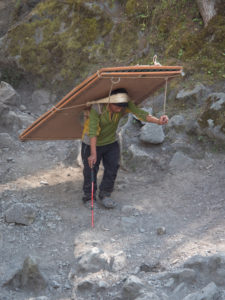 This was one of the more odd materials being transported up the trail.
This was one of the more odd materials being transported up the trail.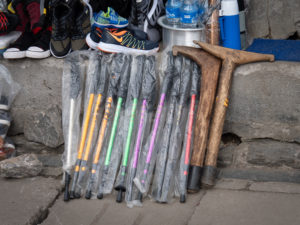
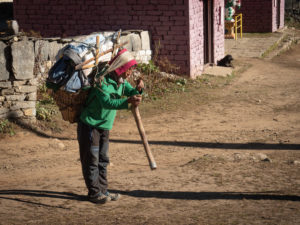
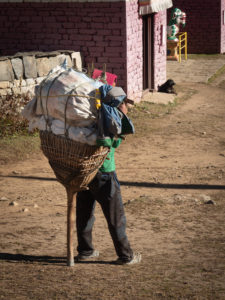 Genius! You can rest ANYWHERE!! All along the trail are low rock walls, largely built maybe for porters to rest their loads. But if there isn’t a wall there is the little wooden crutch!
Genius! You can rest ANYWHERE!! All along the trail are low rock walls, largely built maybe for porters to rest their loads. But if there isn’t a wall there is the little wooden crutch!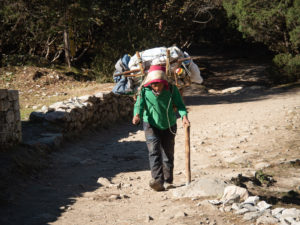 It can also be used as a walking stick.
It can also be used as a walking stick.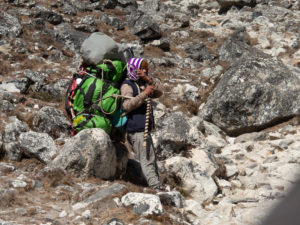 Resting on a rock. He has quite a load.
Resting on a rock. He has quite a load.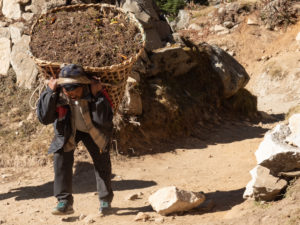 Hauling dirt? As we got higher there were many folks hauling yak dung for fuel as trees became extinct at higher elevations.
Hauling dirt? As we got higher there were many folks hauling yak dung for fuel as trees became extinct at higher elevations.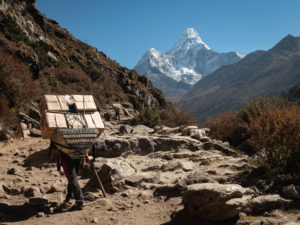
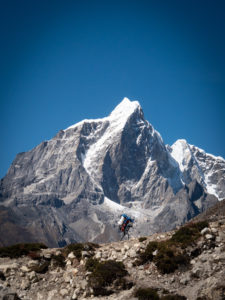
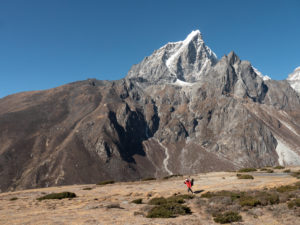
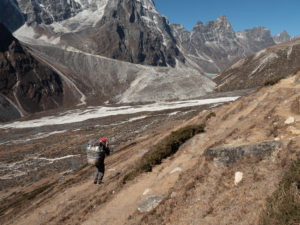
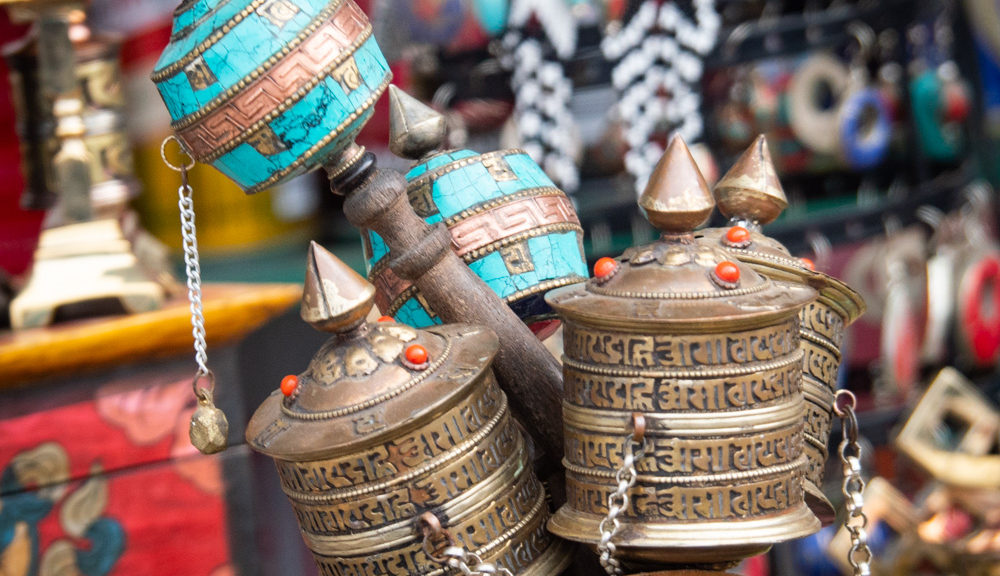
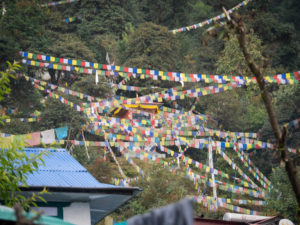
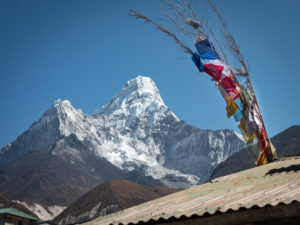
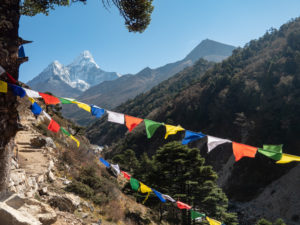
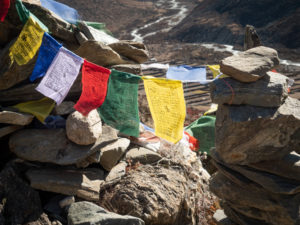
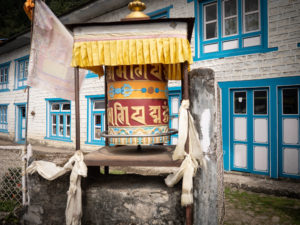
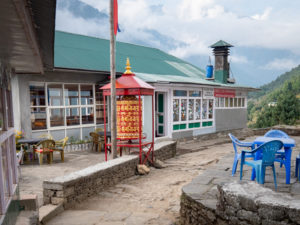
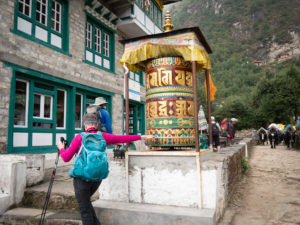
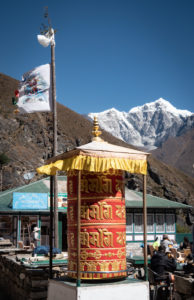
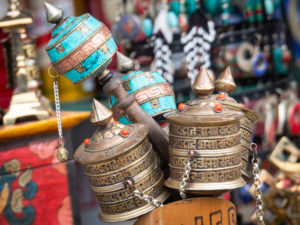
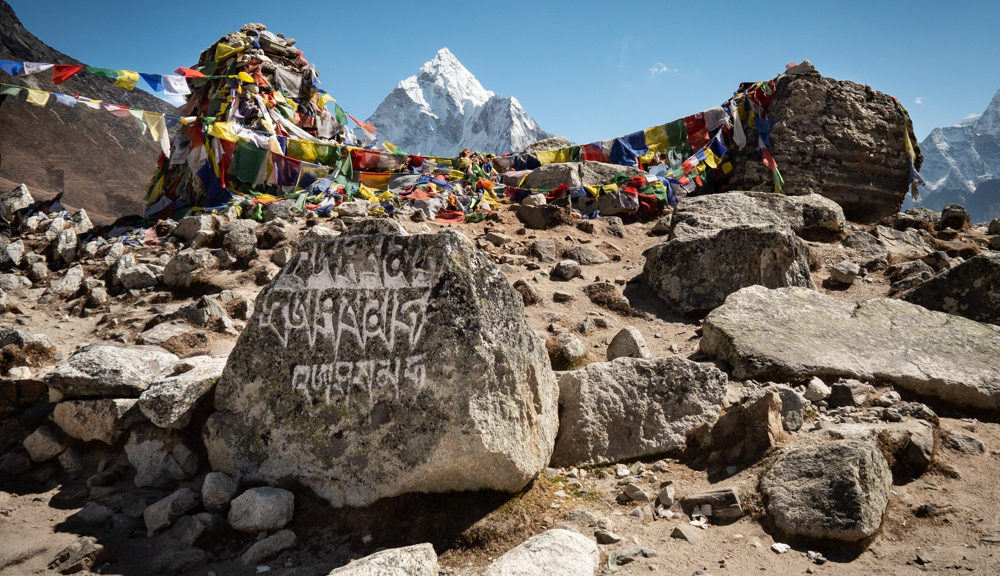
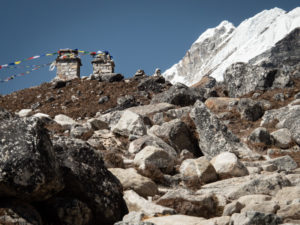
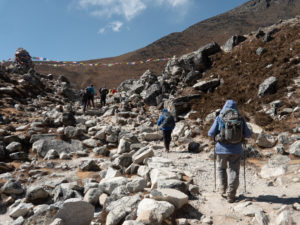
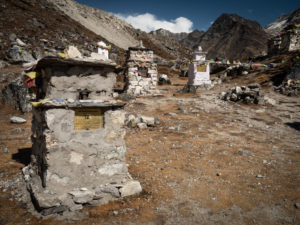
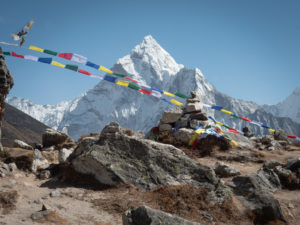
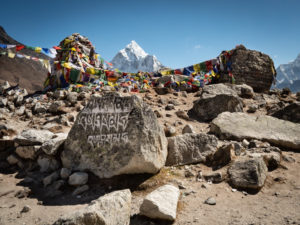
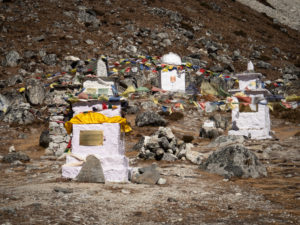
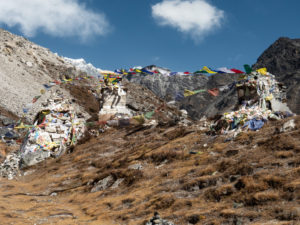
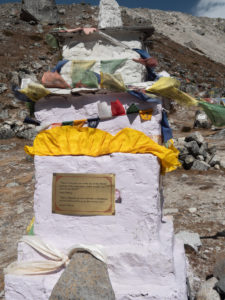
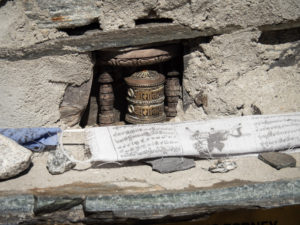
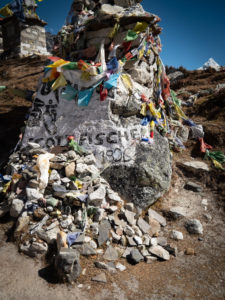 This is the memorial to Scott Fischer, one of ten climbers lost in 1996 in one storm. The movie
This is the memorial to Scott Fischer, one of ten climbers lost in 1996 in one storm. The movie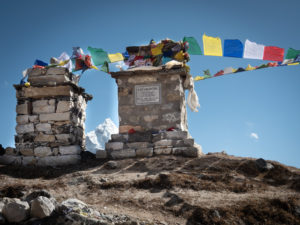
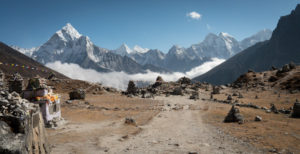 This is the valley of the monuments. Just LOOK at the surrounding mountains. This pass is at 15,846 feet with mountain peaks jutting into the sky another 10,000 feet or so.
This is the valley of the monuments. Just LOOK at the surrounding mountains. This pass is at 15,846 feet with mountain peaks jutting into the sky another 10,000 feet or so.
 This is the bathroom at our first tea lodge. We gave it a five-star as it had these qualities: “western” toilet, shower head AND sink. The amazing thing is that these were all in our room!! The miracle of this would be realized at lodges further up the trail.
This is the bathroom at our first tea lodge. We gave it a five-star as it had these qualities: “western” toilet, shower head AND sink. The amazing thing is that these were all in our room!! The miracle of this would be realized at lodges further up the trail.
 Here is where we began making the transition. No toilet seat or ability to flush as we’re used to. To flush one had to fill the bucket and pour it in.
Here is where we began making the transition. No toilet seat or ability to flush as we’re used to. To flush one had to fill the bucket and pour it in.



 And then there were the fake hybrids. You can see the tank that we think was just there for show, the bucket for paper waste and the cup to wash down your business.
And then there were the fake hybrids. You can see the tank that we think was just there for show, the bucket for paper waste and the cup to wash down your business.




 One of the first examples of what we came to call prayer rocks showed up on this massive wall upon our descent into Sagarmatha National Park. Initially, we thought the words were painted on.
One of the first examples of what we came to call prayer rocks showed up on this massive wall upon our descent into Sagarmatha National Park. Initially, we thought the words were painted on. Upon closer examination, we realized they were etched out of the stone. In other words, the words rose above the background of rock. We assumed it was the monks that did it but never confirmed that.
Upon closer examination, we realized they were etched out of the stone. In other words, the words rose above the background of rock. We assumed it was the monks that did it but never confirmed that. This rock is in the village of Lukla.
This rock is in the village of Lukla. This is one of the few we encountered using various colors. This is at the monastery in Tengboche.
This is one of the few we encountered using various colors. This is at the monastery in Tengboche.

 This one is heading into Dingboche.
This one is heading into Dingboche.
 At times the tablets were just piled into a heap resembling a stupa. A stupa is a Buddhist commemorative monument usually housing sacred relics associated with the Buddha or other saintly persons. The hemispherical form of the stupa appears to have derived from pre-Buddhist burial mounds in India.
At times the tablets were just piled into a heap resembling a stupa. A stupa is a Buddhist commemorative monument usually housing sacred relics associated with the Buddha or other saintly persons. The hemispherical form of the stupa appears to have derived from pre-Buddhist burial mounds in India.

 The eyes of Buddha.
The eyes of Buddha. This is a stupa outside the monastery in Tengboche.
This is a stupa outside the monastery in Tengboche. This is a monument built to remember some climbers who lost there lives on Lhotse, the fourth tallest mountain on Earth.
This is a monument built to remember some climbers who lost there lives on Lhotse, the fourth tallest mountain on Earth. These guys were outside the monastery in Tengboche.
These guys were outside the monastery in Tengboche. Here is a post with intricate carvings on it.
Here is a post with intricate carvings on it. Here’s a stupa base with carvings.
Here’s a stupa base with carvings. This statue was outside our tea lodge in Gorakshep.
This statue was outside our tea lodge in Gorakshep. These paintings were inside a small structure at the entrance to the village of Tengboche.
These paintings were inside a small structure at the entrance to the village of Tengboche.
 On the main thoroughfare, one can purchase trekking poles, water bottles, backpacks, jackets, maps and more.
On the main thoroughfare, one can purchase trekking poles, water bottles, backpacks, jackets, maps and more.  Yak tails showed up occasionally. Not sure why.
Yak tails showed up occasionally. Not sure why. These canisters are for locals and expeditions alike. They are propane tanks for heating and cooking. This type of broom is commonly used throughout Kathmandu and the trek.
These canisters are for locals and expeditions alike. They are propane tanks for heating and cooking. This type of broom is commonly used throughout Kathmandu and the trek. One can purchase a commemorative t-shirt, mala beads or Hindu masks.
One can purchase a commemorative t-shirt, mala beads or Hindu masks.






 The eyes of Buddha are everywhere.
The eyes of Buddha are everywhere. Trinkets were for sale all along the trail. We saved most of our souvenir buying for Kathmandu so as to save on space and weight on the hike.
Trinkets were for sale all along the trail. We saved most of our souvenir buying for Kathmandu so as to save on space and weight on the hike. 

 This is a yak herder’s hut. You can see another one in the background.
This is a yak herder’s hut. You can see another one in the background.




 Here are a couple of young men playing a game in Dingboche.
Here are a couple of young men playing a game in Dingboche. Fixing a bowl of potatoes.
Fixing a bowl of potatoes. Holding hand as they approach steps in Lukla.
Holding hand as they approach steps in Lukla. Tourism is clearly the leading industry in the region. There is a lot of waiting for patrons to enter the shops.
Tourism is clearly the leading industry in the region. There is a lot of waiting for patrons to enter the shops.

 This lady looks like she’s standing in a telephone booth. Cell phone coverage was pretty constant throughout the trek.
This lady looks like she’s standing in a telephone booth. Cell phone coverage was pretty constant throughout the trek. We passed this woman closing her gate as we passed in a small village somewhere along the trail.
We passed this woman closing her gate as we passed in a small village somewhere along the trail.
 The kids were great. We would get waves from windows or they would approach us saying “Namaste”.
The kids were great. We would get waves from windows or they would approach us saying “Namaste”. The exchange of money was cool to watch. There were no coins to speak of. What seemed like a lot of rupees really wasn’t. Ten rupees was really a little over eight cents, not ten dollars.
The exchange of money was cool to watch. There were no coins to speak of. What seemed like a lot of rupees really wasn’t. Ten rupees was really a little over eight cents, not ten dollars. The guy in yellow is getting a helping hand with washing his hair. I’m guessing this means there is no running water in the home.
The guy in yellow is getting a helping hand with washing his hair. I’m guessing this means there is no running water in the home. I thought this was daughter braiding mom’s hair.
I thought this was daughter braiding mom’s hair. We sat with this lady for a while. She had a very active grandson.
We sat with this lady for a while. She had a very active grandson. This little guy couldn’t have been more than three or four years old. He was one of the few children we saw at the upper end of the trek.
This little guy couldn’t have been more than three or four years old. He was one of the few children we saw at the upper end of the trek. We spent the most time in Dingboche. This woman was working in her yard or yak pen as we passed by.
We spent the most time in Dingboche. This woman was working in her yard or yak pen as we passed by. A common sight in this region, people using carrying baskets held from their heads. There were a lot of children in Lukla and less and less the higher we got.
A common sight in this region, people using carrying baskets held from their heads. There were a lot of children in Lukla and less and less the higher we got.
 Here is our expedition with the icefall in the background. One can’t even see Everest from base camp. Who knew?
Here is our expedition with the icefall in the background. One can’t even see Everest from base camp. Who knew?


 This image gives you a little perspective with the guy in the red jacket in the lower right corner. He’s standing near the Kumbhu Glacier.
This image gives you a little perspective with the guy in the red jacket in the lower right corner. He’s standing near the Kumbhu Glacier.

 Ellen is tying off our last set of prayer flags. We hung these for three people: Bonnie Devening, a co-worker of mine who passed away in February of 2018 and for two of Ellen’s siblings who also passed away far too young.
Ellen is tying off our last set of prayer flags. We hung these for three people: Bonnie Devening, a co-worker of mine who passed away in February of 2018 and for two of Ellen’s siblings who also passed away far too young. Here are their flags.
Here are their flags. There were chunks of ice jutting up all over.
There were chunks of ice jutting up all over. Looking around we were trying to figure out where one would set up an expedition base camp.
Looking around we were trying to figure out where one would set up an expedition base camp.

 I love the Nepalese flag. It is so unique.
I love the Nepalese flag. It is so unique.